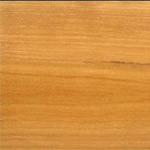Serving Upstate NY—VT—MA • For selections & prices, CALL or EMAIL US
Satinwood (Yellowheart)
Wood Flooring Species
Scientific Name:
Zanthoxylum flavum or West Indian Satinwood, is a true satinwood in the Rutaceae family.
Euxylophora paraensis was once commonly called Brazilian Satinwood. While it is also in the Rutaceae family, technically speaking, it is not a true satinwood, and commercially it goes by the name Yellowheart.
Although these two species are different, their respective names are often used interchangeably; and indeed, they are both very similar in appearance. However, Yellowheart does not have the same strong grain figure found in genuine satinwood and is not quite as hard. Moreover, Yellowheart is relatively inexpensive compared to other imported species.
Other Names and Species:
Aceitillo
Bois Noyer
Bois Noyes
Brazilian Satinwood
Espinillo
Jamaican Satinwood
Kalabarie
Pau Amarello
Prickly Ash
Tembetaria
West Indian Satinwood
Yellow Sanders
Yellow Wood
Yellowheart
Origin:
Southern Florida to Brazil
Appearance:
The sapwood and heartwood of satinwood are both golden tan to orange in color. The species has an interlocked or irregular, sometimes roey or mottled grain, is high lustered, and is fairly even and fine in texture.
Properties:
Satinwood has a natural resistance to termite attack. The wood is reported to have a coconut oil odor when freshly cut. Although it is a harder species of wood, satinwood’s durability in regard to wear is somewhat lower than that of other woods. Satinwood can be somewhat difficult and time-consuming to dry properly.
Janka Hardness: 1820 (Zanthoxylum flavum)
As a flooring option, true satinwood is a fairy hard wood. It is identical in hardness to hickory or pecan, a little over a third harder than white oak, over twenty-five percent harder than hard maple, only forty percent softer than purpleheart’s ranking of 1860, and just under eighty-three percent as hard as santos mahogany’s ranking of 2200.
The Janka Hardness of Yellowheart (Euxylophora paraensis) is 1790.
Workability:
Satinwood is relatively easy to saw properly. The wood holds both nails and glue well once applied. This species sands fairly well and takes a fine polish due to its lustrous properties.
Principal Uses:
Satinwood’s uses include veneer, furniture, cabinets, and inlay work.
Learn more about available grades of
Yellowheart hardwood flooring »





